A Geological Context in Radiation Risk Assessment to the Public
Abstract
:1. Introduction
2. Average Radioactivity of Primordial Radioisotopes in Various Rock Formations
| Rock | 238U Bq·kg−1 | 232Th Bq·kg−1 | 40K Bq·kg−1 |
|---|---|---|---|
| Kimberlites | 39 | 64 | 540 |
| Mafic | 6 | 8 | 210 |
| Gabbro | 6–9 | 8–16 | 240 |
| Basalt | 6–12 | 6–10 | 270 |
| Trachybasalt | 30 | 32 | 810 |
| Andesite | 15–30 | 16–32 | 540 |
| Dacite | 30 | 40 | 720 |
| Quartz-porphyry | 57 | 78 | 1170 |
| Granite | 42–60 | 60–204 | 1110–1410 |
| Granitoid | 21–162 | 18–52 | 720–1200 |
| Miaskite nepheline syenite | 126 | 114 | 1560 |
| Nepheline syenite | 174 | 194 | - |
3. Study Area
4. Materials and Methods
4.1. Sampling and Preperation
4.2. Gamma Measurement Details
- 1460.8 keV for 40K
- 63.3 keV; 92.3–92.8 keV (234Thequi.) for 238U
- 609.3 keV (214Biequi.) and 295.2 keV; 351.9 keV (214Pbequi.) for 226Ra
- 2614.5 keV; 583.1 keV (208Tlequi.), 727.3 keV (212Biequi.) and 238.6 keV (212Pbequi.) for 228Th
- 911.2 keV; 338.3 keV (228Acequi.) for 228Ra
- uncertainty of peak area calculation;
- uncertainty of the emission probability;
- uncertainty from the sample mass determination.
- uncertainty of self-absorption;
- uncertainty from the background subtraction;
- certified uncertainty from radioactivity of a reference material;
- uncertainty of the efficiency calibration;
4.3. Absorbed Dose Rate
4.4. Geological Map
5. Results and Discussion
6. Conclusions
- geological composition of the bedrock influences the level of the radioactivity in a given area;
- the groups of specific bedrock components were indicated which contribute the largest share to ADR;
- the ADR values for the majority of measurements points are a little higher than the mean values of ADR for Poland and the world;
- in the investigated research area, radiological risk seems to be negligible to tourists, as values do not deviate from globally occurring values and almost 10% of the population lives in areas with higher terrestrial radioactivity. The entire TPN area has not been studied, but based on the sampling points, a significant increase in exposure in the rest of region seems improbable
- the use of basic chemometric tools on the one hand shows the correlations between variables and on the other hand allows us to make predictions about the range of radioactivity in research area;
- the proposed method of bedrock analysis appears to be suitable for predicting NORM isotope content. This may help to determine new measurement points and obtain a representative sample during radioecological studies and risk assessment research and;
- the limitation to 0.5 square kilometers in the analysis of the bedrock, that resulted from the assumption, seems to have been the right approach because it takes into account various forms of terrain.
Author Contributions
Funding
Institutional Review Board Statement
Informed Consent Statement
Data Availability Statement
Conflicts of Interest
References
- Ault, T.; Krahn, S.; Croff, A. Radiological Impacts and Regulation of Rare Earth Elements in Non-Nuclear Energy Production. Energies 2015, 8, 2066–2081. [Google Scholar] [CrossRef]
- Stobiński, M.; Jędrzejek, F.; Kubica, B. Preliminary studies on the spatial distribution of artificial Cs and natural gamma radionuclides in the region of the Ojców National Park, Poland. Nukleonika 2018, 63, 105–111. [Google Scholar] [CrossRef]
- Walencik-Łata, A.; Szkliniarz, K.; Kisiel, J.; Polaczek-Grelik, K.; Jędrzejczak, K.; Kasztelan, M.; Szabelski, J.; Orzechowski, J.; Tokarski, P.; Marszał, W.; et al. Characteristics of Natural Background Radiation in the GIG Experimental Mine ‘Barbara’, Poland. Energies 2022, 15, 685. [Google Scholar] [CrossRef]
- Reczyński, W.; Szarłowicz, K.; Jakubowska, M.; Bitusik, P.; Kubica, B. Comparison of the sediment composition in relation to basic chemical, physical, and geological factors. Int. J. Sediment Res. 2020, 35, 307–314. [Google Scholar] [CrossRef]
- Joseph, S.R.; Kim, J. Radiological Dose Assessment to Members of the Public Using Consumer Products Containing Naturally Occurring Radioactive Materials in Korea. Int. J. Environ. Res. Public Health 2021, 18, 7337. [Google Scholar] [CrossRef] [PubMed]
- Rajaretnam, G.; Blasio, C.; Lovins, K.; Spitz, H. Effect of leachability on environmental risk assessment for naturally occurring radioactive materials (NORM) in petroleum oil fields. Health Phys. 1996, 6, 191–198. [Google Scholar]
- Desideri, D.; Meli, M.A.; Feduzi, L.; Roselli, C. The importance of radiochemistry for the characterization of NORM and of environments contaminated by NORM. Int. J. Environ. Anal. Chem. 2006, 86, 601–613. [Google Scholar] [CrossRef]
- Stobinski, M.; Szarlowicz, K.; Reczynski, W.; Kubica, B. The evaluation of 137Cs radioactivities in soils taken from the Babia Góra National Park. J. Radioanal. Nucl. Chem. 2014, 299, 631–635. [Google Scholar] [CrossRef] [PubMed]
- Szarłowicz, K.; Stobiński, M.; Jedrzejek, F.; Kubica, B. Sedimentary conditions based on the vertical distribution of radionuclides in small dystrophic lakes: A case study of Toporowe Stawy Lakes (Tatra Mountains, Poland). Environ. Sci. Pollut. Res. 2022. [CrossRef] [PubMed]
- Emsley, J. Nature’s Building Blocks: An A-Z Guide to the Elements; Oxford University Press: Oxford, UK, 2011. [Google Scholar]
- de Laeter, J.R.; Böhlke, J.K.; De Bièvre, P.; Hidaka, H.; Peiser, H.S.; Rosman, K.J.R.; Taylor, P.D.P. Atomic weights of the elements. Review 2000 (IUPAC Technical Report). Pure Appl. Chem. 2003, 75, 683–800. [Google Scholar] [CrossRef]
- Marshall, C.P.F.R.W. Encyclopedia of Geochemistry; Kluwer Academic Publishers: Dordrecht, The Netherlands; Boston, MA, USA, 1999. [Google Scholar]
- IAEA. Guidelines for Radioelement Mapping Using Gamma Ray Spectrometry Data; International Atomic Energy Agency: Vienna, Austria, 2003. [Google Scholar]
- Herring, J.S. Uranium Uranium and Thorium Thorium Resources Uranium Resources; Springer: New York, NY, USA, 2012; pp. 11201–11219. [Google Scholar]
- Lide, D.R. CRC Handbook of Chemistry and Physics, 85th ed.; Taylor & Francis: Abingdon, UK, 2004. [Google Scholar]
- IAEA. World Distribution of Uranium Deposits (UDEPO) with Uranium Deposit Classification; International Atomic Energy Agency: Vienna, Austria, 2009. [Google Scholar]
- Tissot, F.L.H.; Dauphas, N. Uranium isotopic compositions of the crust and ocean: Age corrections, U budget and global extent of modern anoxia. Geochim. Cosmochim. Acta 2015, 167, 113–143. [Google Scholar] [CrossRef] [Green Version]
- Harmsen, K.; Haan, F.A.M.D. Occurance and behaviour of uranium and thorium in soil and water. Neth. J. Agric. Sci. 1980, 28, 40–62. [Google Scholar] [CrossRef]
- René, M. Nature, Sources, Resources, and Production of Thorium; InTech: London, UK, 2017. [Google Scholar]
- Sanjurjo-Sánchez, J.; Alves, C. Geologic materials and gamma radiation in the built environment. Environ. Chem. Lett. 2017, 15, 561–589. [Google Scholar] [CrossRef]
- Anderson, D.L. Theory of the Earth; Blackwell Scientific Publications: Boston, MA, USA, 1989. [Google Scholar]
- Reimann, C.; de Caritat, P. Chemical Elements in the Environment. Factsheets for the Geochemist and Environmental Scientist. Geol. Mag. 2000, 137, 593–598. [Google Scholar] [CrossRef]
- Committee on Uranium Mining in Virginia. Scientific, Technical, Environmental, Human Health and Safety, and Regulatory Aspects of Uranium Mining and Processing in Virginia; The National Academies Press: Washington, DC, USA, 2012; p. 359. [Google Scholar]
- Schmus, W.R.V. Radioactivity Properties of Minerals and Rocks. In CRC Handbook of Physical Properties of Rocks; CRC Press: Boca Raton, FL, USA, 1984. [Google Scholar]
- Kondracki, J. Geografia Regionalna Polski; Wydawnictwo Naukowe PWN: Warszawa, Poland, 1998. [Google Scholar]
- Narodowe, P.P. Tatrzański Park Narodowy. Available online: https://zpppn.pl/tatrzanski-park-narodowy-pl/park (accessed on 10 September 2022).
- Statistics Poland, Standards and Registers Department. Area and Population in the Territorial Profile in 2020. Warsaw, Poland 2020. Available online: https://stat.gov.pl/download/gfx/portalinformacyjny/en/defaultaktualnosci/3286/4/14/1/area_and_population_in_the_territorial_profile_in_2020.pdf (accessed on 10 September 2022).
- TPN. Tatrzański Park Narodowy, “Doszacowania 2013–2020”. Available online: https://tpn.pl/pobierz-plik/12db05e10d3094d4b87e16bf5681c5c7/Doszacowania_2013_2021d.pdf (accessed on 10 September 2022).
- Polish Geological National Institute.Mapa Geologiczna Polski w skali 1:500 000. Web Map Service. 2022. Available online: http://cbdgmapa.pgi.gov.pl/arcgis/services/kartografia/mgp500k/MapServer/WMSServer? (accessed on 10 September 2022).
- Klimaszewski. Sculpture of Polish Tatras; Polish Scientific Publishers PWN: Warsaw, Poland, 1988. [Google Scholar]
- Klimaszewski, M. Budowa Geologiczna. In Rzeźba Tatr Polskich; Państwowe Wydawnictwo Naukowe: Warsaw, Poland, 1988. [Google Scholar]
- Komornicki, T. Gleby. In Przyroda Tatrzańskiego Parku Narodowego; TPN—PAN: Kraków, Poland, 1996. [Google Scholar]
- Bednarek, R. Czynniki i procesy glebotwórcze. In Gleboznawstwo; Wydawnictwo Naukowe PWN: Warszawa, Poland, 2020. [Google Scholar]
- Skiba, S. Rola klimatu i roślinności w genezie gleb górskich na przykładzie gleb z Tatr Polskich i z gór Mongolii. In Proceedings of the Zeszyty Naukowe AR w Krakowie. University of Agriculture in Krakow; University of Agriculture in Krakow: Cracow, Poland, 1985. [Google Scholar]
- Misiak, R.; Hajduk, R.; Stobinski, M.; Bartyzel, M.; Szarlowicz, K.; Kubica, B. Self-absorption correction and efficiency calibration for radioactivity measurement of environmental samples by gamma-ray spectrometry. Nukleonika 2011, 56, 23–28. [Google Scholar]
- United Nations Scientific Committee on the Effects of Atomic Radiation. Sources and Effects of Ionizing Radiation, Annex B: Exposures from Natural Radiation Sources; United Nations: New York, NY, USA, 2000; p. 217. [Google Scholar]
- Ku, H.H. Notes on the Use of Propagation of Error Formulas. J. Res. Natl. Bur. Stand.—C 2010. [Google Scholar]
- Polish Geological National Institute. Szczegółowa Mapa Geologiczna Tatr w skali 1:10 000; PIG: Warsaw, Poland, 2015. [Google Scholar]
- Neuendorf, K.K.E.; Mehl, J.P., Jr.; Jackson, J.A. Glossary of Geology; American Geological Institute: Alexandria, Virginia, 2011. [Google Scholar]
- Robert, S.; Anderson, S.P.A. Weathering. In Geomorphology: The Mechanics and Chemistry of Landscapes; Cambridge Univeristy Press: Cambridge, UK, 2010; pp. 161–209. [Google Scholar]
- UNSCEAR. Sources and Effects of Ionizing Radiation—ANNEX B Exposures of the Public and Workers from Various Sources of Radiation; Unitied Nations: San Francisco, CA, USA, 2008. [Google Scholar]
- Biernacka, M.; Isajenko, K.; Lipiński, P.; Pietrzak-Flis, Z. Radiation Atlas of Poland 2005; Biblioteka Monitoringu Środowiska: Warsaw, Poland, 2006. [Google Scholar]
- IAEA. Radiation Protection of the Public and the Environment; International Atomic Energy Agency: Vienna, Austria, 2018. [Google Scholar]

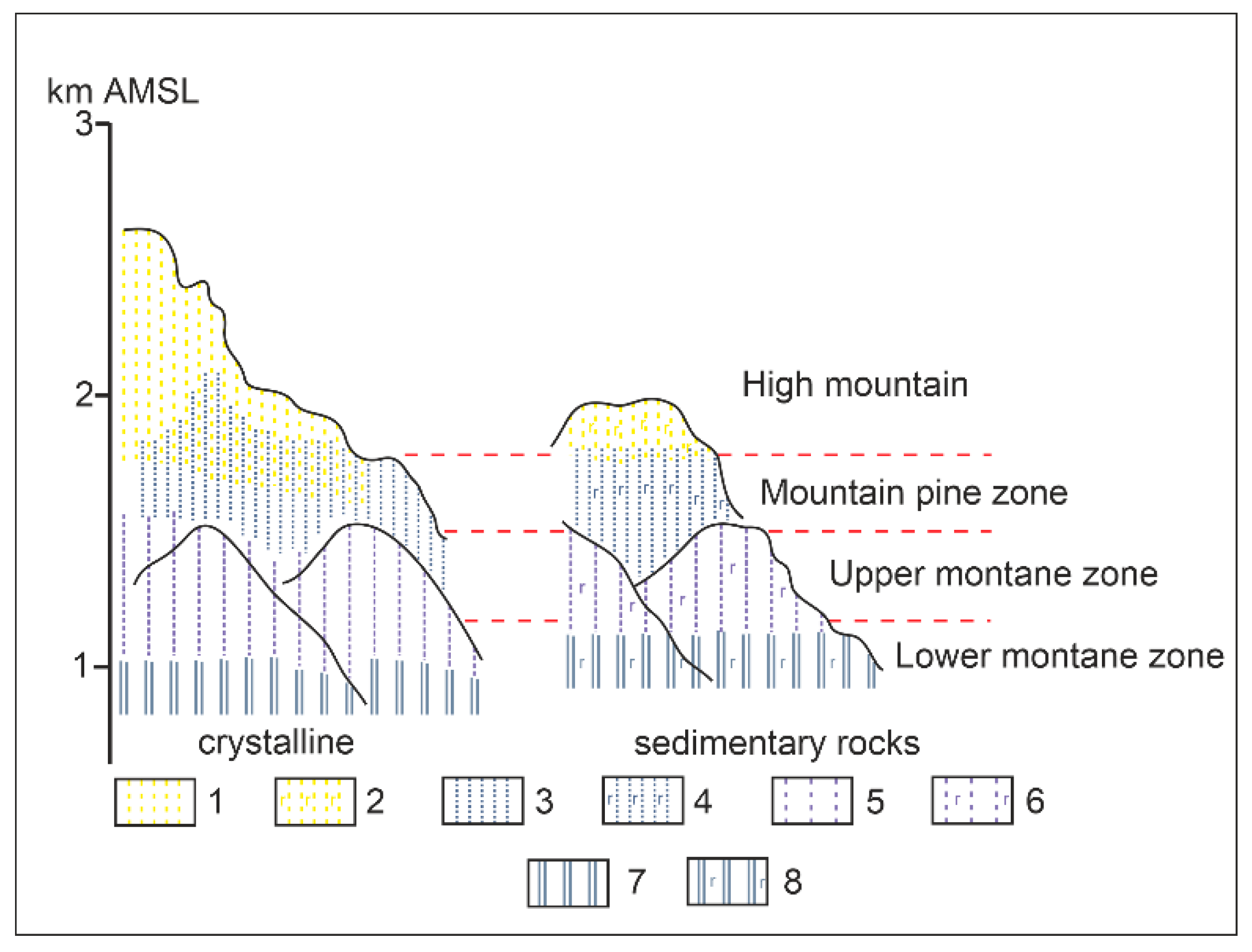
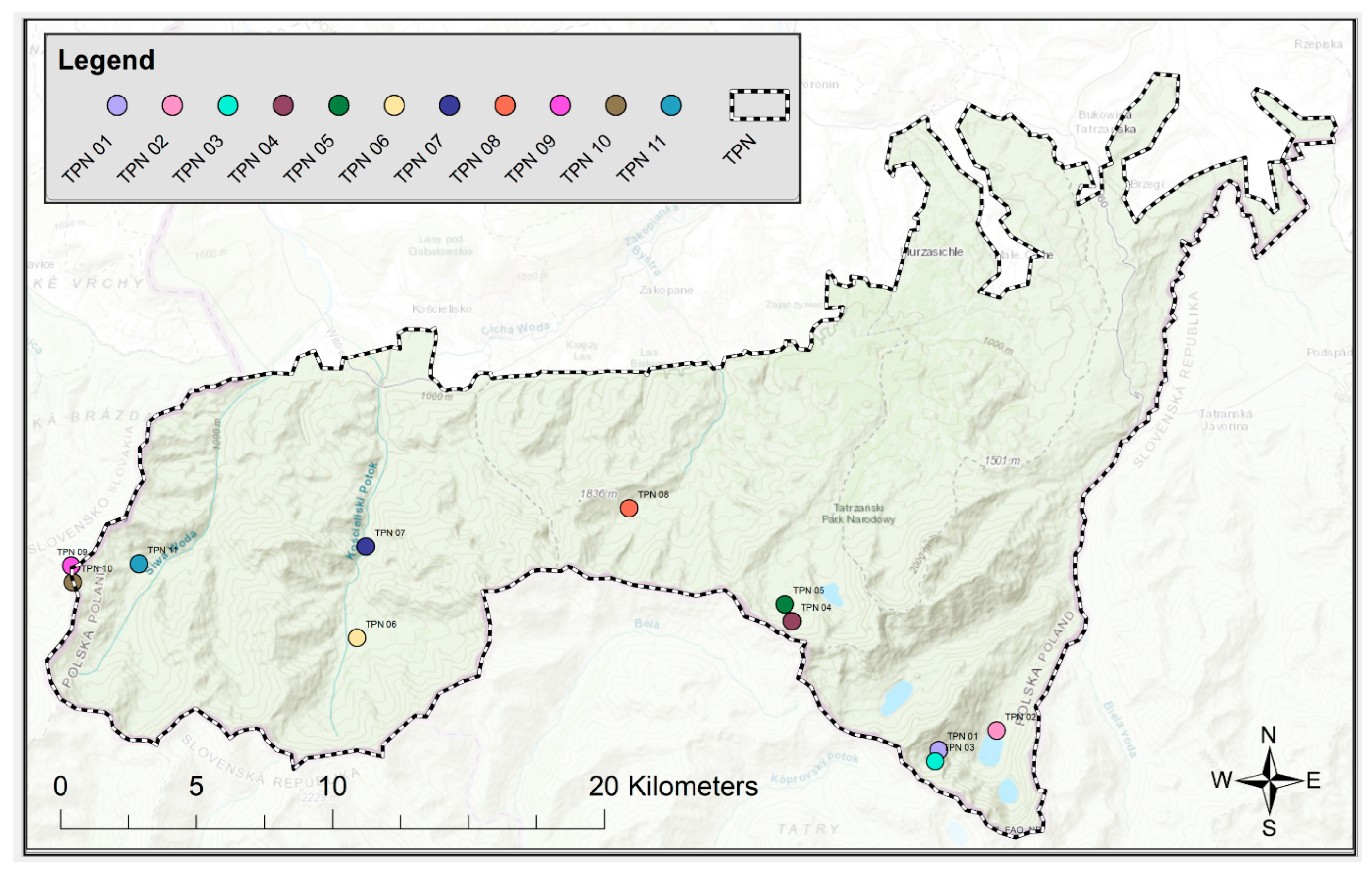
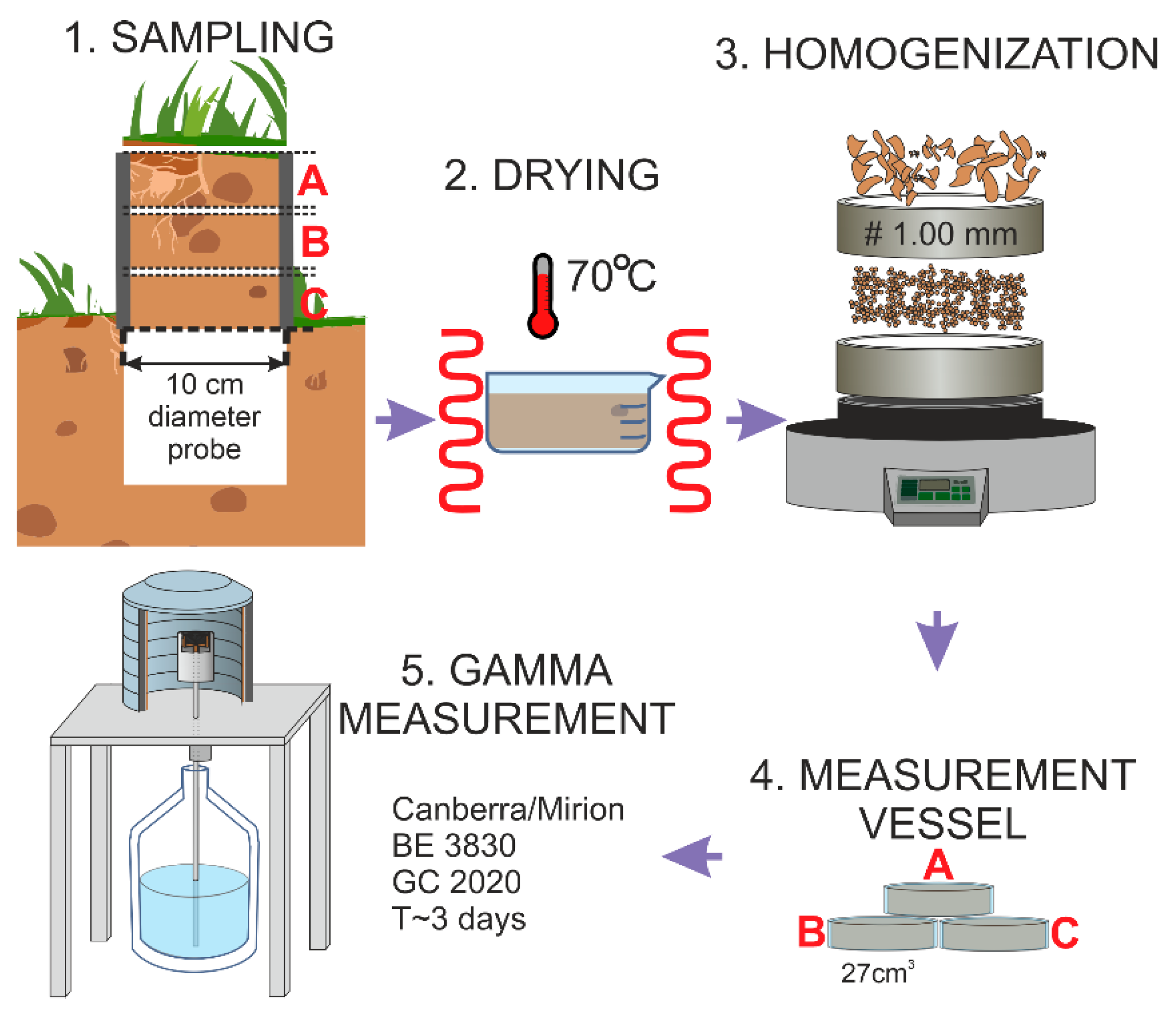

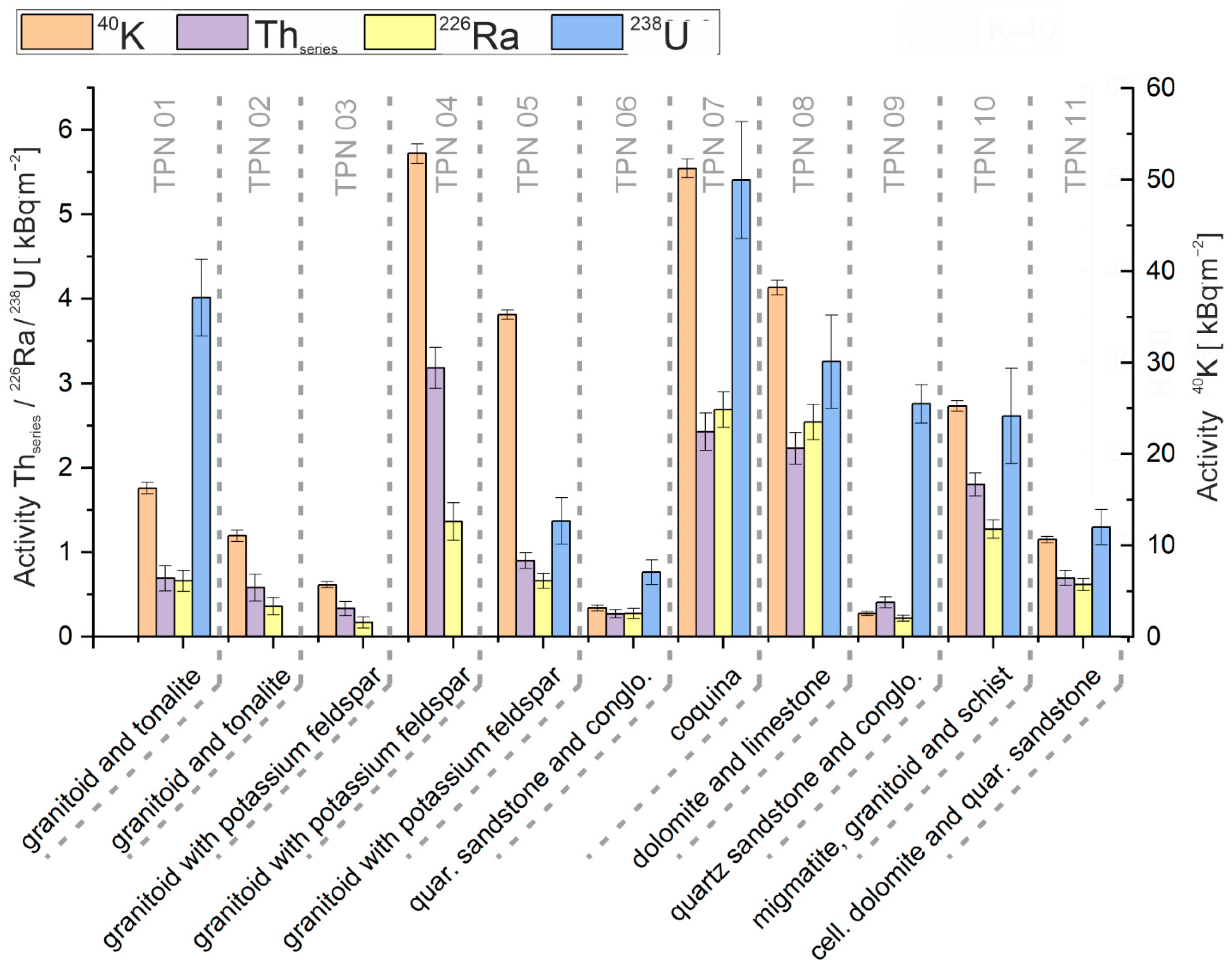
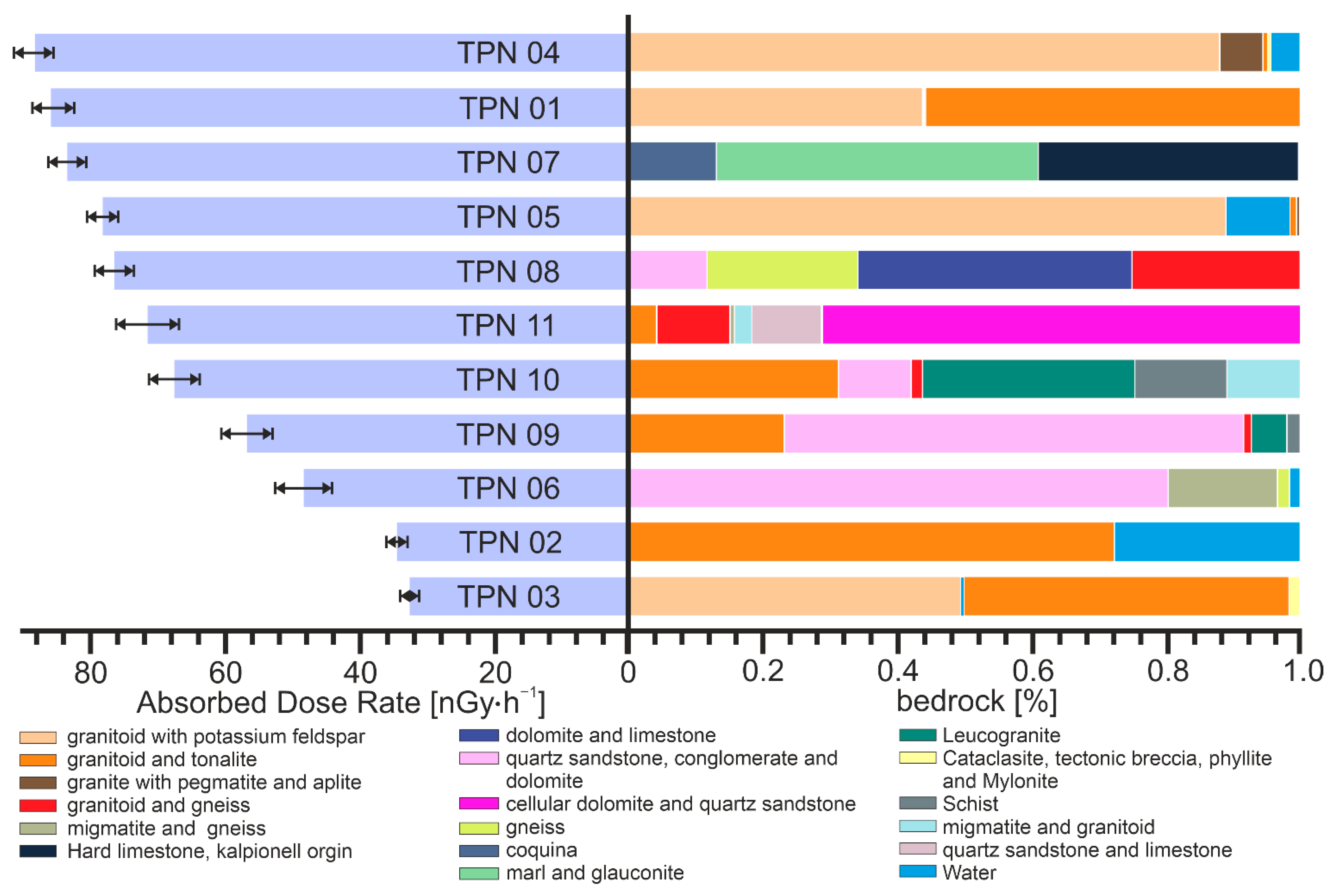

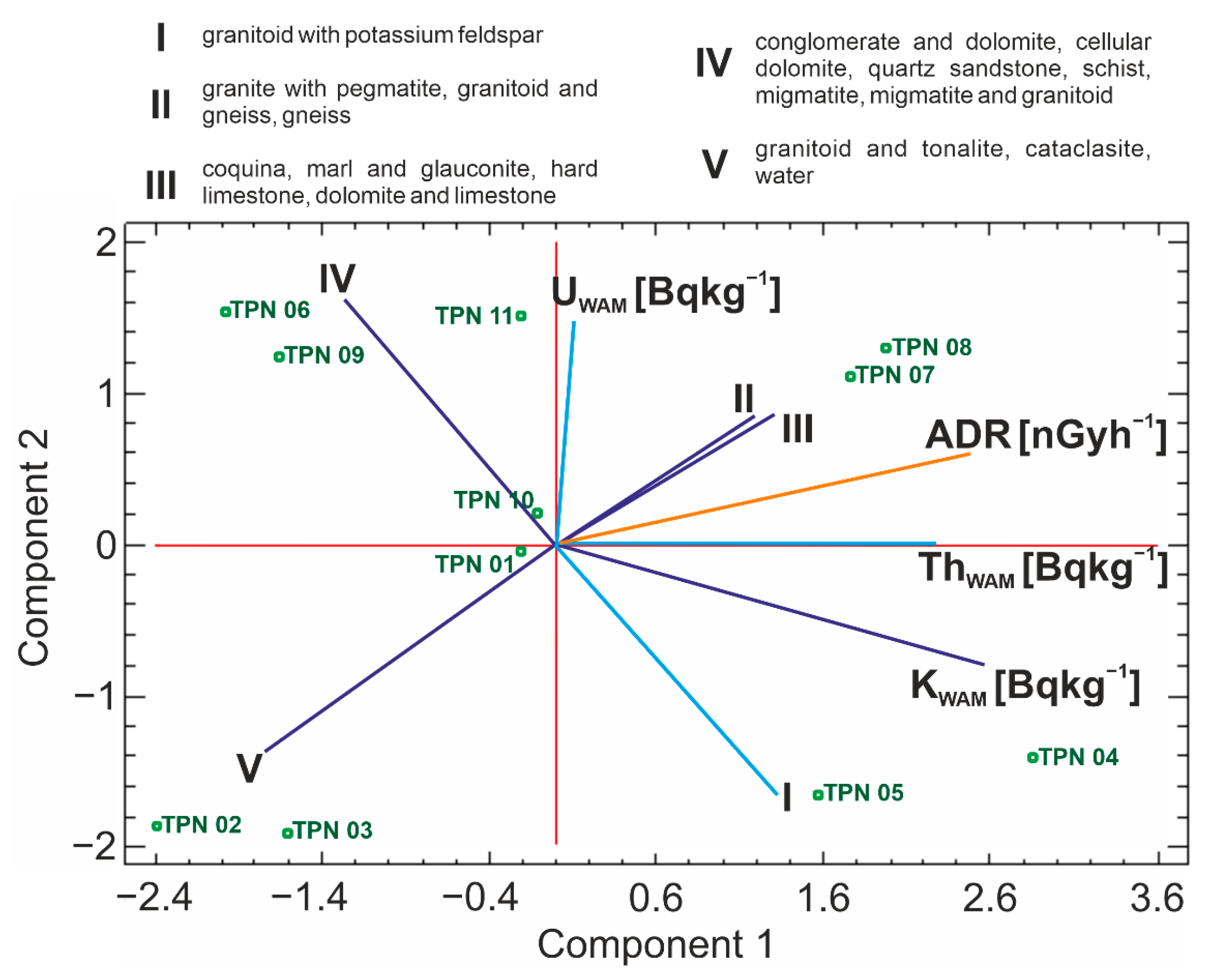
| ID | Latitude | Longitude | Altitude [mAMSL] | Label | Depth [cm] |
|---|---|---|---|---|---|
| TPN01 | 49.1969444 | 20.053333333333335 | 1789 | TPN 01A | 0–3 |
| TPN 01B | 3–6 | ||||
| TPN 01C | 6–10 | ||||
| TPN02 | 49.2011111 | 20.072499999999998 | 1449 | TPN 02A | 0–3 |
| TPN 02B | 3–6 | ||||
| TPN 02C | 6–10 | ||||
| TPN03 | 49.1945833 | 20.052194444444446 | 1853 | TPN 03A | 0–3 |
| TPN 03B | 3–6 | ||||
| TPN 03C | 6–10 | ||||
| TPN04 | 49.2246561 | 20.004876944444444 | 1849 | TPN 04A | 0–3 |
| TPN 04B | 3–6 | ||||
| TPN 04C | 6–10 | ||||
| TPN05 | 49.2283411 | 20.002531944444446 | 1689 | TPN 05A | 0–3 |
| TPN 05B | 3–6 | ||||
| TPN 05C | 6–10 | ||||
| TPN06 | 49.2210833 | 19.861194444444447 | 1242 | TPN 06A | 0–3 |
| TPN 06B | 3–6 | ||||
| TPN 06C | 6–10 | ||||
| TPN07 | 49.2408333 | 19.86416666666667 | 1054 | TPN 07A | 0–3 |
| TPN 07B | 3–6 | ||||
| TPN 07C | 6–10 | ||||
| TPN08 | 49.2490278 | 19.95111111111111 | 1348 | TPN 08A | 0–3 |
| TPN 08B | 3–6 | ||||
| TPN 08C | 6–10 | ||||
| TPN09 | 49.2366469 | 19.76671861111111 | 1630 | TPN 09A | 0–3 |
| TPN 09B | 3–6 | ||||
| TPN 09C | 6–10 | ||||
| TPN10 | 49.2330839 | 19.767203888888886 | 1606 | TPN 10A | 0–3 |
| TPN 10B | 3–6 | ||||
| TPN 10C | 6–10 | ||||
| TPN11 | 49.2370681 | 19.78908388888889 | 1213 | TPN 11A | 0–3 |
| TPN 11B | 3–6 | ||||
| TPN 11C | 6–10 |
| ID | 40K [Bq·kg−1] | [u] | 228Th [Bq·kg−1] | [u] | 228Ra [Bq·kg−1] | [u] | 226Ra [Bq·kg−1] | [u] | 238U [Bq·kg−1] | [u] |
|---|---|---|---|---|---|---|---|---|---|---|
| TPN 01A | 251 | 23 | 11.6 | 7.5 | 13.9 | 6.6 | 13.0 | 3.3 | 92 | 20 |
| TPN 01B | 478 | 15 | 18.2 | 2.8 | 18.7 | 3.4 | 21.6 | 3.8 | 111 | 11 |
| TPN 01C | 535 | 16 | 20.4 | 5.5 | 22.4 | 3.5 | 18.9 | 3.3 | 124 | 11 |
| TPN 02A | 297 | 25 | 13.2 | 5.5 | 18.4 | 6.7 | 8.3 | 2.3 | MDA | MDA |
| TPN 02B | 308 | 20 | 16.0 | 6.0 | 14.8 | 5.4 | 12.3 | 2.6 | MDA | MDA |
| TPN 02C | 535 | 19 | 25.3 | 5.1 | 26.3 | 4.3 | 17.0 | 2.1 | MDA | MDA |
| TPN 03A | 203 | 27 | 12.6 | 6.3 | 15.5 | 7.9 | 7.7 | 2.8 | MDA | MDA |
| TPN 03B | 257 | 18 | 10.9 | 4.7 | 13.0 | 3.9 | 8.5 | 1.9 | MDA | MDA |
| TPN 03C | 546 | 18 | 31.4 | 4.7 | 32.2 | 4.2 | 14.3 | 3.3 | MDA | MDA |
| TPN 04A | 204 | 16 | 12.9 | 5.6 | 10.1 | 4.9 | 8.5 | 3.9 | MDA | MDA |
| TPN 04B | 514 | 18 | 37.3 | 5.0 | 39.5 | 4.4 | 16.8 | 3.4 | MDA | MDA |
| TPN 04C | 1204 | 18 | 67.4 | 3.8 | 68.5 | 3.6 | 28.5 | 3.7 | 40.6 | 9.7 |
| TPN 05A | 736 | 17 | 20.6 | 6.6 | 19.0 | 3.6 | 16.0 | 4.4 | 36 | 10 |
| TPN 05B | 1031 | 15 | 22.8 | 2.9 | 24.9 | 2.6 | 18.6 | 2.0 | 38.8 | 7.6 |
| TPN 05C | 1041 | 15 | 27.1 | 4.1 | 29.2 | 2.6 | 20.0 | 2.9 | 40.6 | 7.5 |
| TPN 06A | 287 | 15 | 9.2 | 3.5 | MDA | MDA | 5.9 | 2.5 | MDA | MDA |
| TPN 06B | 196 | 16 | 15.4 | 5.3 | 14.2 | 4.6 | 13.2 | 4.2 | 42 | 13 |
| TPN 06C | 97 | 18 | 24.1 | 6.4 | 25.1 | 3.9 | 22.4 | 3.7 | 71 | 11 |
| TPN 07A | 607 | 15 | 28.2 | 3.7 | 30.2 | 3.3 | 35.0 | 3.2 | 53 | 14 |
| TPN 07B | 710 | 14 | 34.9 | 4.8 | 32.6 | 3.1 | 38.8 | 2.6 | 61.5 | 8.9 |
| TPN 07C | 742 | 14 | 32.9 | 4.5 | 35.3 | 3.0 | 37.4 | 3.0 | 88.2 | 8.7 |
| TPN 08A | 498 | 20 | 23.9 | 5.9 | 29.8 | 5.1 | 34.2 | 4.2 | 37 | 15 |
| TPN 08B | 650 | 15 | 38.7 | 5.1 | 40.1 | 3.3 | 44.9 | 3.7 | 59.2 | 9.6 |
| TPN 08C | 729 | 14 | 41.4 | 3.4 | 41.3 | 3.1 | 47.5 | 3.6 | 61.1 | 9.1 |
| TPN 09A | 52 | 12 | 5.5 | 2.2 | 7.2 | 2.9 | MDA | MDA | 158 | 15 |
| TPN 09B | 200 | 15 | 31.2 | 5.2 | 32.9 | 4.7 | 18.6 | 3.6 | 175 | 14 |
| TPN 09C | 204 | 14 | 33.7 | 4.4 | 35.0 | 3.4 | 21.8 | 3.2 | 180 | 14 |
| TPN 10A | 588 | 15 | 37.8 | 4.0 | 43.2 | 3.8 | 29.3 | 3.0 | 65 | 15 |
| TPN 10B | 626 | 14 | 40.0 | 3.6 | 42.5 | 3.3 | 30.4 | 2.6 | 62 | 14 |
| TPN 10C | 642 | 14 | 13.7 | 3.4 | 48.4 | 3.1 | 35.2 | 2.4 | 67 | 13 |
| TPN 11A | 152 | 22 | 7.5 | 3.8 | 9.8 | 4.4 | 7.9 | 2.3 | MDA | MDA |
| TPN 11B | 454 | 16 | 27.4 | 4.3 | 31.8 | 4.1 | 28.5 | 3.8 | 55 | 12 |
| TPN 11C | 616 | 14 | 36.0 | 3.3 | 37.2 | 3.2 | 33.3 | 1.6 | 82.1 | 9.1 |
| Component Number | Eigenvalue | Percent of Variance | Cumulative Percentage |
|---|---|---|---|
| 1 | 3.258 | 36.20 | 36.20 |
| 2 | 2.090 | 23.23 | 59.42 |
| 3 | 1.276 | 14.18 | 73.61 |
| 4 | 1.118 | 12.43 | 86.03 |
| 5 | 0.643 | 7.15 | 93.18 |
| 6 | 0.412 | 4.58 | 97.76 |
| 7 | 0.201 | 2.24 | 100.00 |
| 8 | 1.05 × 10−12 | 0.000 | 100.00 |
| 9 | 1.71 × 10−16 | 0.000 | 100.00 |
| Component | Component | Component | Component | |
|---|---|---|---|---|
| 1 | 2 | 3 | 4 | |
| I | 0.252 | −0.481 | 0.3687 | −0.210 |
| V | −0.334 | −0.401 | −0.040 | 0.302 |
| IV | −0.239 | 0.468 | 0.0663 | −0.519 |
| II | 0.228 | 0.246 | −0.514 | −0.074 |
| III | 0.251 | 0.248 | −0.246 | 0.645 |
| KWAM [Bq·kg−1] | 0.489 | −0.228 | 0.0081 | −0.010 |
| UWAM [Bq·kg−1] | 0.022 | 0.430 | 0.602 | 0.257 |
| ThWAM [Bq·kg−1] | 0.436 | 0.003 | −0.217 | −0.325 |
| ADR [nGy·h−1] | 0.472 | 0.174 | 0.352 | 0.053 |
Publisher’s Note: MDPI stays neutral with regard to jurisdictional claims in published maps and institutional affiliations. |
© 2022 by the authors. Licensee MDPI, Basel, Switzerland. This article is an open access article distributed under the terms and conditions of the Creative Commons Attribution (CC BY) license (https://creativecommons.org/licenses/by/4.0/).
Share and Cite
Jędrzejek, F.; Szarłowicz, K.; Stobiński, M. A Geological Context in Radiation Risk Assessment to the Public. Int. J. Environ. Res. Public Health 2022, 19, 11750. https://doi.org/10.3390/ijerph191811750
Jędrzejek F, Szarłowicz K, Stobiński M. A Geological Context in Radiation Risk Assessment to the Public. International Journal of Environmental Research and Public Health. 2022; 19(18):11750. https://doi.org/10.3390/ijerph191811750
Chicago/Turabian StyleJędrzejek, Filip, Katarzyna Szarłowicz, and Marcin Stobiński. 2022. "A Geological Context in Radiation Risk Assessment to the Public" International Journal of Environmental Research and Public Health 19, no. 18: 11750. https://doi.org/10.3390/ijerph191811750





